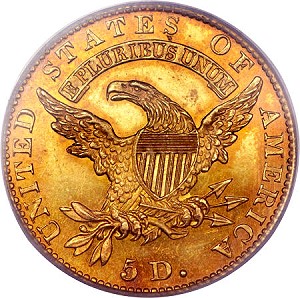Analysis on scarce coins, markets, and the coin collecting community #88
A Weekly Column by Greg Reynolds
This is my third column regarding coins that will be auctioned by Heritage during Platinum Night sessions at the upcoming FUN Convention in Orlando. Harvey Jacobson’s collection of early Half Eagles (U.S. $5 gold coins) will be sold on Thursday, Jan. 5, right after Dr. Duckor’s set of Saints, which I covered two weeks ago. Last week, I wrote about Denis Loring’s set of 1793 cents. Although Jacobson collected many Half Eagles dating from 1795 to 1831, this offering of a portion of his coin collection will be best remembered for his Capped Head Half Eagles of the first type, the so called ‘Large Size’ or ‘Large Date.’
Of all series of U.S. coins, the most difficult to even 80% complete are Capped Head Half Eagles. Indeed, there are, by far, more Great Rarities in this series than in any other. For a coin issue to be a Great Rarity, fewer than twenty-five coins must be known to exist, of all die varieties, including business strikes and Proofs. There are a few Great Rarities in the Jacobson Collection. Several other pieces are extremely rare, meaning that fewer than one hundred are known. These are classic rarities that have been strongly demanded by collectors since the middle of the 19th century.
I. What are Capped Head Half Eagles?
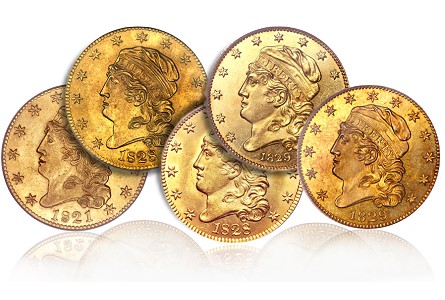 Half Eagles are U.S. $5 gold coins. These were produced from 1795 to 1929. Half Eagle types are: Bust Right – Small Eagle (1795-98), Bust Right – Heraldic Eagle (1795-1807), Bust Left (1807-1812), Capped Head – “Large” (1813-29), Capped Head – “Small” (1829-24), Classic Head (1834-38), Liberty Head – ‘No Motto’ (1839-66) Liberty Head – ‘With Motto’ (1866-1908), and Indian Head (1908-29). Commemorative $5 gold coins that have been minted, at various times, since 1986 are in a different category. Also, I recently wrote about Bust Right Half Eagles. (As before, clickable links are in blue.)
Half Eagles are U.S. $5 gold coins. These were produced from 1795 to 1929. Half Eagle types are: Bust Right – Small Eagle (1795-98), Bust Right – Heraldic Eagle (1795-1807), Bust Left (1807-1812), Capped Head – “Large” (1813-29), Capped Head – “Small” (1829-24), Classic Head (1834-38), Liberty Head – ‘No Motto’ (1839-66) Liberty Head – ‘With Motto’ (1866-1908), and Indian Head (1908-29). Commemorative $5 gold coins that have been minted, at various times, since 1986 are in a different category. Also, I recently wrote about Bust Right Half Eagles. (As before, clickable links are in blue.)
Capped Head Half Eagles are sometimes incorrectly termed ‘Bust Half Eagles’ or ‘Capped Bust Half Eagles.’ In the contexts of coins or sculptures, a ‘bust’ must include artistic representations of at least one shoulder and a portion of the subject’s chest, in addition to a head. A Capped Head Half Eagle portrays the head and neck of a female personification of Liberty.
Half Eagles minted from 1795 to 1812 are Bust Half Eagles; those minted from 1813 to 1834 are NOT Bust Half Eagles. Consider the definition in the Wikipedia, which I believe to be consistent with how the term ‘bust’ was defined by artisans for centuries: “A bust is a sculpted or cast representation of the upper part of the human figure, depicting a person’s head and neck, as well as a variable portion of the chest and shoulders.”
Though all Capped Head Half Eagles feature a capped head, there was a noticeable change in design in 1829. Capped Head Half Eagles of the first type are usually distinguished from those of the second type by referring to those dated from 1813 to early 1829 as ‘Large Date’ coins and those dating from later in 1829 to 1834 as ‘Small Date’ coins. The distinction between ‘large date’ and ‘small date’ refers to the size of the numerals in the year on each coin. A “smaller set of numeral and letter punches was used on the new type of Half Eagle,” David Stone explains. He is a researcher and cataloguer at Heritage.
The second type is of a slightly smaller diameter than the first type. According to researcher Breen, the diameter of Half Eagles from 1795 to 1829 is one inch, approximately 25.4 millimeters. Due to the use of ‘open collar’ technology, however, the diameter of the ‘Large Date’ (type 1) Capped Head Half Eagles varies to an almost significant extent.
The diameter established at some point in 1829 for the second type of Capped Head Half Eagle is fifteen sixteenths (15/16) of an inch, 23.8125 millimeters. These were all struck with a ‘close collar,’ a snug edge instrument that braced and imparted reeds upon each prepared blank while it was being struck. Also, Breen gives the impression that, until 1873, the metric system was not used at all in the formulation of specifications for U.S. coins, and, even after 1873, the traditional Anglo-American system was still used to a considerable extent. Diameters were thus measured in inches, not millimeters.
At some point during the era in which Capped Head Half Eagles were minted, the value of the gold contained in each Half Eagle rose significantly above the face value of five dollars. Therefore, people in the bullion business had a strong incentive to melt them and would even pay significantly more than $5 for each. So, an extremely large percentage of all Capped Head Half Eagles were melted.
A new coinage law was passed in 1834 and Classic Head Half Eagles, which were minted from 1834 to 1838, contained less gold than Capped Head Half Eagles. The survival rate for all other types of Half Eagles is much higher than the survival rate for Capped Head Half Eagles.
Among ‘dates’ with normal numerals, the 1822 is clearly the rarest Capped Head Half Eagle. Only three are known, and two of the three are in the Smithsonian Institution, in Washington. The third, the Eliasberg piece, was auctioned by the firm of Bowers & Ruddy in October 1982. It has been in a private collection in the Southwest ever since. It was graded ‘Extremely Fine-40’ (or 45?) by the NGC in the early 1990s.
There is some debate as to whether there exist just two 1825/4 overdate Half Eagles or more than the two if coins that were previously thought to be 1825/1 overdates are really 1825/4 overdates. This matter really requires a separate discussion.
As far as I know, Jacobson does not have a blatant 1825/4 overdate. This consignment does, though, include an “1825/1,” which is PCGS graded “MS-62” and has a CAC sticker. Jacobson amassed an amazing array of Capped Head Half Eagles of the first type.
“Except for one, it was a great group of Half Eagles from of the 1820s,” John Albanese remarks. “These are among the toughest series of U.S. coins from any one decade. While it is hard to find rare date Capped Head Half Eagles in any grade, they tend to come nice when you do see them. Quarter Eagles from the 1790s are very tough” to find in high grades, John says. Albanese is the president and founder of the CAC.
Saul Teichman states, “for a run like this, you would have to go to the Bass sales in 1999, and prior to that to the Eliasberg (1982), Norweb (1987), Byron Reed (1996) and maybe Keston (1996) sales for any [auctions] containing this many” of the ‘Large Date’ (Large Diameter) type of Capped Head Half Eagles. “It is a pretty neat run,” Saul exclaims.
Jim McGuigan asserts likewise that this is “the best collection of Capped Head Half Eagles of the 1820s to be sold since the Keston sale” in 1996. McGuigan is a specialist in early gold coins.
II. The 1829 ‘Large Date’
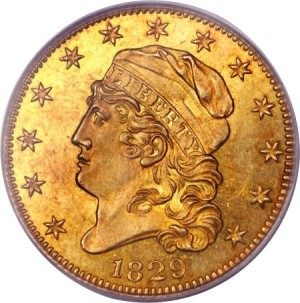 Clearly, the most valuable coin in Harvey Jacobson’s current run is his 1829 ‘Large Date’ Half Eagle. In 1829, Capped Head Half Eagles of both types were minted, and both these 1829 issues are Great Rarities. Jacobson has the 1829 ‘Large Date’ (Type 1) that was formerly in the epic Garrett Family Collection and was auctioned in 1979 and 1980 by the firm of Bowers & Ruddy. Breen, Ron Guth, Saul Teichman, and the Heritage cataloguers all seem to be in agreement that just seven 1829-‘Large Date’ Half Eagles are known.
Clearly, the most valuable coin in Harvey Jacobson’s current run is his 1829 ‘Large Date’ Half Eagle. In 1829, Capped Head Half Eagles of both types were minted, and both these 1829 issues are Great Rarities. Jacobson has the 1829 ‘Large Date’ (Type 1) that was formerly in the epic Garrett Family Collection and was auctioned in 1979 and 1980 by the firm of Bowers & Ruddy. Breen, Ron Guth, Saul Teichman, and the Heritage cataloguers all seem to be in agreement that just seven 1829-‘Large Date’ Half Eagles are known.
The Jacobson 1829 was auctioned by the firm of Bowers & Ruddy on Nov. 29, 1979 in New York, as part of the Garrett I sale. Also, it was offered by Stack’s in Oct. 1988, as part of a consignment of a collectively owned group of gold coins that was organized by Les and Sue Fox.
The ‘news’ in regards to the Garrett-Jacobson 1829 is that it is now certified as a Proof. A reference to lot number #120 in the Keston sale in the current Heritage catalogue together with information on the PCGS Coin Facts site indicate that this 1829 ‘Large Date’ was PCGS graded “MS-64” when Superior offered it as part of the Michael Keston Collection in 1996. In past works, Garrett & Guth in 2006, and Guth separately on the old CoinFacts site, do not refer to this coin as a Proof. To the best of my recollection at the moment, David Akers has not, in writing, given any indication that he believes it is a Proof.
In contrast, in the Garrett I catalogue, the cataloguer (presumably QDB) stated that this coin “is Choice Brilliant Uncirculated, MS-65, with a nearly fully prooflike surface; Quite possibly this piece was struck as a Proof, it is definitely a special striking, perhaps a presentation piece” [Bold lettering and italics are in the original.] Similarly, in the Stack’s catalogue for the auction of October 5, 1988, Norman Stack described this coin as “Gem Brilliant Uncirculated – Fully prooflike with many of the characteristics of a true Proof. At the very least, this coin is a presentation piece or special striking of some sort” (lot #82 on p. 63).
The Garrett-Jacobson 1829 is now PCGS certified “Proof-64” and it has been approved by the CAC. Albanese states that “it is not a business strike.” I look forward to examining it in Orlando.
Not only is the Garrett-Jacobson ‘Large Date’ 1829 the only 1829 ‘Large Date’ to be certified as a “Proof,” it is the only coin of the whole ‘Large Date’ (large diameter) Capped Head Half Eagle type to be certified as a Proof by the PCGS. Further, the NGC has not certified any coins of this type as Proofs. While there is not a Proof 1829 ‘Large Date’ in the Smithsonian, there are Proof ‘Large Date’ Capped Head (Type 1) Half Eagles of other issues from the 1820s in the Smithsonian.
I have never seen the Norweb-Bass 1821 Half Eagle. Descriptions put forth by experts make it sound like it is a Proof. In contrast, descriptions that I have read of “1825/1” Half Eagles that have been referred to as Proofs are inconsistent and/or ambiguous.
The Heritage cataloguer refers to two 1820 Half Eagles as Proofs. I have never seen either of them. One is the Norweb-Bass 1820, which Jeff Garret is not convinced is a Proof. The PCGS CoinFacts website, however, refers to it as a Proof that may be graded 65 if it is ever submitted to the PCGS. The other 1820 was auctioned by New England Rare Coin Galleries in 1979, and, as far as I know, has not been publicly offered since 1979.
The Godard-Duckor 1921 Double Eagle and the Garrett-Jacobson 1829 Half Eagle may be the two most valuable coins in the Jan. 5th Platinum Night event. To the best of my knowledge, it has been more than ten years since any 1829 ‘Large Date’ Half Eagle has been publicly offered.
III. 1828/7 Half Eagle
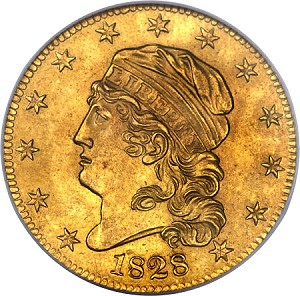 The 1828/7 is even rarer than the 1829 ‘Large Date.’ Saul Teichman has identified five 1828/7 Half Eagles. This one is the highest certified. The Eliasberg 1828/7, though, was graded “MS-63” by the NGC between 1990 and 1995. Would it receive a higher grade if it was to be resubmitted in 2012?
The 1828/7 is even rarer than the 1829 ‘Large Date.’ Saul Teichman has identified five 1828/7 Half Eagles. This one is the highest certified. The Eliasberg 1828/7, though, was graded “MS-63” by the NGC between 1990 and 1995. Would it receive a higher grade if it was to be resubmitted in 2012?
In any event, the Reed-Suros-Jacobson 1828/7 is NGC graded MS-64 and probably has been since 1999 or earlier. Christie’s auctioned it in New York in 1996. In 2011, it was CAC approved. Although Saul has traced just five, David Akers has asserted that there are a few more than five. In my view, even if there one to three other currently unknown coins, the 1828/7 seems to be about as rare as the 1829 ‘Large Date.’
Curiously, Dr. Suros formed a collection of overdates, including the Byron Reed 1828/7, this coin. Superior Galleries auctioned the Suros Collection of overdates in Feb. 1999. As with the 1829 ‘Large Date,’ I do not remember an 1828/7 being auctioned since 1999.
IV. 1828 ‘Normal Numerals’
 The Jacobson 1828, with normal numerals, has a terrific pedigree (history of ownership). By ‘normal numerals,’ I am referring to regular numerals, and thus not to an overdate, a doubled date or a markedly repunched date. Other writers refer to normal numerals in the year as a ‘normal date’ or as a ‘perfect date.’ I honestly believe that my term makes more sense. Regarding coins, the term ‘date’ refers to far more than just a year, and most numerals are far from perfect.
The Jacobson 1828, with normal numerals, has a terrific pedigree (history of ownership). By ‘normal numerals,’ I am referring to regular numerals, and thus not to an overdate, a doubled date or a markedly repunched date. Other writers refer to normal numerals in the year as a ‘normal date’ or as a ‘perfect date.’ I honestly believe that my term makes more sense. Regarding coins, the term ‘date’ refers to far more than just a year, and most numerals are far from perfect.
The Jacobson 1828 has been traced to the Farish Baldenhofer Collection, which is one of the most under-rated collections of all time. It contained many exemplary representatives of famous rarities. Stack’s auctioned the Baldenhofer collection in 1955. The Jacobson 1828 was later in the Samuel Wolfson and Ted Naftzger Collections. It was last auctioned when Superior Galleries sold the Michael Keston Collection in 1996.
The Baldenhofer-Naftzger-Jacobson 1828 is PCGS graded MS-64 and has a CAC sticker. Albanese found it be “very original.” In my tentative view, it is likely to be one of the top four of fifteen or so that exist.
V. 1821 Half Eagle
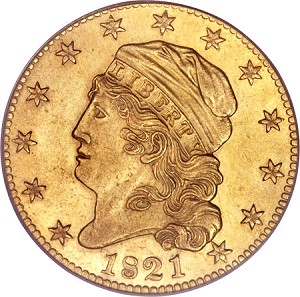 The Jacobson 1821 is PCGS graded AU-58 and has a sticker from the CAC. While a few higher quality 1821 Half Eagles exist, this issue is rarer than many collectors realize.
The Jacobson 1821 is PCGS graded AU-58 and has a sticker from the CAC. While a few higher quality 1821 Half Eagles exist, this issue is rarer than many collectors realize.
I am not convinced that there are as many as eleven 1821 Half Eagles. The data published by the PCGS and the NGC includes some multiple counts of individual coins. Indeed, the Heritage cataloguers list only six different 1821 Half Eagles that have appeared at auction. Jim McGuigan suggests that “eight to twelve” survive.
McGuigan specializes in pre-1840 U.S. coins of all metals. “Gold collectors tend to be a little more secretive about their holdings than early copper collectors. So, it is hard to say how many are around,” Jim finds. “It is much harder to get information about gold coins than early copper coins. Copper collectors often allow their coins to be photographed and they generally share information,” McGuigan emphasizes.
VI. 1829 ‘Small Date’
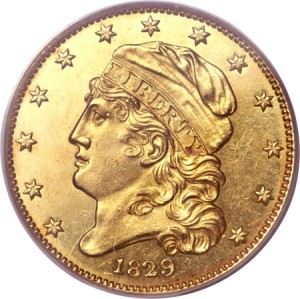 Although the focus here is on the ‘Large Date’ (Large Diameter) Capped Head Half Eagles, as this offering of coins from the Jacobson Collection will be best remembered for these, it is important to mention the Jacobson 1829 ‘Small Date’ here. The second 1829 is a Great Rarity, too, and it is particularly notable that Harvey Jacobson obtained representatives of both 1829s.
Although the focus here is on the ‘Large Date’ (Large Diameter) Capped Head Half Eagles, as this offering of coins from the Jacobson Collection will be best remembered for these, it is important to mention the Jacobson 1829 ‘Small Date’ here. The second 1829 is a Great Rarity, too, and it is particularly notable that Harvey Jacobson obtained representatives of both 1829s.
The Jacobson 1829 ‘Small Date’ is PCGS graded “MS-61” and is CAC approved. It was formerly in the Harry Bass Collection and was auctioned by the firm of Bowers & Merena in New York during October 1999.
Saul Teichman identified ten distinct 1829 ‘Small Date’ Half Eagles. David Stone figures that there may exist as many as twelve. I agree.
So, Jacobson obtained representatives of the 1828, 1828/7, and both 1829s, four Great Rarities of the same denomination (the Half Eagle) from a two year time period.
“Collections containing both 1828s and both 1829s are extremely rare,” Teichman finds. Saul “can only think of the H.P. Smith, Eliasberg, Newcomer, Col. Green, Lilly and Bass Foundation collections having all four. [Saul] would have to check the Brand journals to see if Virgil Brand had an 1828 perfect date. William Woodin did not have an 1828/7 or an 1829 ‘Large Date’ at the 1914 ANS exhibit,” Teichman adds. Woodin was a large contributor to that epic exhibit, which featured many Great Rarities that were loaned by several collectors.
H. P. Smith’s 1828/7, 1828 normal and 1829 ‘Large Date’ were all acquired by John M. Clapp and later inherited by John H. Clapp. In 1942, Louis Eliasberg, Sr., purchased the entire Clapp Collection intact for $100,000, a grand sum at the time. Stack’s brokered this deal.
According to Teichman, Waldo Newcomers’ 1828/7, 1828 and two 1829s were all sold to Col. Green, probably through B. Max Mehl. “When the Col Green gold coins were purchased by Stack’s circa 1943-44, the Green Collection had many duplicates, the primary and most complete set was sold to King Farouk,” Teichman reports.
Saul’s point is that only a very small number of the leading collectors of U.S. gold coins in the 20th century were able to acquire representatives of all these four Great Rarities. There is a collection in the Southwest that contains all four, which were all probably acquired in the 20th century. A reliable source suggests that Jacobson started seriously collecting rare gold coins in the 21st century. Is he the only collector to acquire all four of these in this century?
Since “the early nineties, I have only seen any of these four a few times,” Jim McGuigan declares. “This auction is an opportunity for a serious collector to start, or [further] work on, a set of Capped Head Half Eagles. There has not been such an opportunity in fifteen years,” states McGuigan. John Albanese likewise remarks that this is the “nicest group of Capped Head Half Eagles from the 1820s that I have seen since the early 1990s.”
I am puzzled as to why Jacobson did not come closer to finishing a set of Capped Head Half Eagles. Apparently, he can afford to do so. Many of his Bust Half Eagles are expensive. If he had focused more intently on Capped Head Half Eagles, could he have formed one of the all-time best sets of this type? While he may never have obtained two or three dates, he could have obtained quite a few more than he did. If this auction includes Jacobson’s entire holding of Capped Head Half Eagles (and it may not), he is missing dates that are much less rare than several of the dates that he obtained. Also, it is curious that he did not obtain an 1815, which, historically, has been one of the most famous coin issues of all.
©2011 Greg Reynolds


